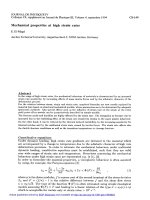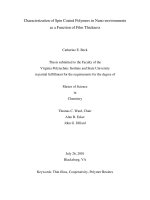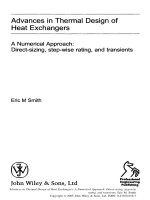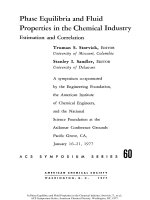- Trang chủ >>
- Khoa Học Tự Nhiên >>
- Vật lý
fluid properties at nano-, meso scale. a numerical treatment, 2008, p.234
Bạn đang xem bản rút gọn của tài liệu. Xem và tải ngay bản đầy đủ của tài liệu tại đây (17.1 MB, 234 trang )
P1: ABC/ABC/SPH P2: ABC
fm JWBK251-Ransing June 20, 2008 21:20 Printer Name: Yet to Come
Fluid Properties at
Nano/Meso Scale
Fluid Properties at Nano/Meso Scale: A Numerical Treatment P. Dyson, R. S. Ransing, P. M. Williams and P. R. Williams
© 2008 John Wiley & Sons, Ltd. ISBN: 978-0-470-75124-4
P1: ABC/ABC/SPH P2: ABC
fm JWBK251-Ransing June 20, 2008 21:20 Printer Name: Yet to Come
The Wiley Microsystem and Nanotechnology Series
Editor: Ronald Pethig
Gerlach Introduction to Microsystem Technology: A Guide March 2008
for Students
Koch, Evans & Microfluidic Technology and Applications November 2000
Brunnschweiler
P1: ABC/ABC/SPH P2: ABC
fm JWBK251-Ransing June 20, 2008 21:20 Printer Name: Yet to Come
Fluid Properties at
Nano/Meso Scale:
A Numerical Treatment
Peter Dyson
Rajesh S. Ransing
Paul M. Williams
P. Rhodri Williams
School of Engineering
Swansea University, UK
A John Wiley and Sons, Ltd, Publication
P1: ABC/ABC/SPH P2: ABC
fm JWBK251-Ransing June 20, 2008 21:20 Printer Name: Yet to Come
This edition first published 2008
C
2008 John Wiley & Sons, Ltd
Registered office
John Wiley & Sons Ltd, The Atrium, Southern Gate, Chichester, West Sussex, PO19 8SQ,
United Kingdom
For details of our global editorial offices, for customer services and for information about how to apply
for permission to reuse the copyright material in this book please see our website at www.wiley.com.
The right of the author to be identified as the author of this work has been asserted in accordance with
the Copyright, Designs and Patents Act 1988.
All rights reserved. No part of this publication may be reproduced, stored in a retrieval system, or
transmitted, in any form or by any means, electronic, mechanical, photocopying, recording or
otherwise, except as permitted by the UK Copyright, Designs and Patents Act 1988, without the prior
permission of the publisher.
Wiley also publishes its books in a variety of electronic formats. Some content that appears in print
may not be available in electronic books.
Designations used by companies to distinguish their products are often claimed as trademarks. All
brand names and product names used in this book are trade names, service marks, trademarks or
registered trademarks of their respective owners. The publisher is not associated with any product or
vendor mentioned in this book. This publication is designed to provide accurate and authoritative
information in regard to the subject matter covered. It is sold on the understanding that the publisher
is not engaged in rendering professional services. If professional advice or other expert assistance is
required, the services of a competent professional should be sought.
Library of Congress Cataloging-in-Publication Data
Fluid properties at nano/Meso scale : a numerical treatment / Rajesh S. Ransing [et al.].
p. cm.
Includes bibliographical references and index.
ISBN 978-0-470-75124-4 (cloth)
1. Fluid dynamics. 2. Fluid dynamics–Data processing. I. Ransing, R. S.
QA911.F5645 2008
620.1
06—dc22 2008024095
A catalogue record for this book is available from the British Library.
ISBN: 978-0-470-75124-4
Set in 10/12pt Times by Aptara Inc., New Dehli, India
Printed in Singapore by Markono
P1: ABC/ABC/SPH P2: ABC
fm JWBK251-Ransing June 20, 2008 21:20 Printer Name: Yet to Come
Contents
Biographies ix
Series Preface xi
Preface xiii
Symbols and Abbreviations xvii
1 The Nature of Fluid Flow 1
1.1 Introduction 1
1.2 Basics of fluid motion 1
1.2.1 Continuum/bulk properties 3
1.2.2 Continuum approximations 8
1.2.3 Continuum scale simulation 11
1.3 Molecular mechanics 16
1.3.1 Molecular properties 16
1.3.2 Molecular simulations 18
1.4 Types of simulation 20
1.4.1 Monte Carlo simulation 22
1.4.2 Molecular dynamics 25
1.4.3 Introduction to the physics of MD simulations 25
1.4.4 Hard sphere model 32
1.4.5 Soft sphere model 35
1.5 Effects at molecular scale 36
1.5.1 Phase change in confined systems 36
1.5.2 Adsorption/desorption in pores 39
1.6 Summary 43
P1: ABC/ABC/SPH P2: ABC
fm JWBK251-Ransing June 20, 2008 21:20 Printer Name: Yet to Come
vi CONTENTS
2 Fluid Physics at Meso Scales 45
2.1 Introduction 45
2.2 Top-down approach for meso scale computation 46
2.2.1 Continuum limit 46
2.2.2 Top-down meso scale methods 50
2.3 Bottom up approach for meso scale computation 55
2.3.1 Molecular dynamics model 55
2.3.2 Boundary conditions 57
2.3.3 Bottom-up meso scale methods 60
2.4 Summary 65
3 Meso Scale Model Based on First Principles 67
3.1 Introduction 67
3.2 Fluid physics model 68
3.2.1 Book keeping 68
3.2.2 Force interactions 70
3.2.3 Time integration scheme 70
3.2.4 Boundary conditions 75
3.2.5 Modified boundary potential 80
3.3 Extracting local bulk properties 81
3.3.1 Approximation method 82
3.3.2 Bin averaging 82
3.3.3 Smooth particle hydrodynamics (SPH) 83
3.3.4 Moving least squares 86
3.3.5 Weight functions 92
3.3.6 Grid structure implementation 94
3.3.7 Sampling 95
3.4 Verification of proposed meso scale model 96
3.5 Summary 102
4 Enhancements to the Meso Scale Model 103
4.1 Introduction 103
4.2 Driving forces 104
4.3 Thermostats 106
4.3.1 Gaussian thermostat 106
4.3.2 Nos
´
e–Hoover 108
4.4 Case studies 110
4.4.1 Sampling 110
4.4.2 Gradient study 119
4.5 Summary 125
P1: ABC/ABC/SPH P2: ABC
fm JWBK251-Ransing June 20, 2008 21:20 Printer Name: Yet to Come
CONTENTS vii
5 Modelling Fluid Regimes at Nano/Meso Scales 127
5.1 Introduction 127
5.2 Flow regimes 128
5.2.1 Laminar flow 130
5.2.2 Turbulent flow 132
5.3 Fluid flow characterization from molecular simulation 133
5.3.1 Characteristics of low-speed molecular flow 134
5.3.2 Characteristics of high-speed molecular flow 136
5.3.3 Comparisons and data analysis 137
5.4 Summary 142
6 Performance of Proposed Meso Scale Model 143
6.1 Introduction 143
6.2 Issues in using large numbers of molecules 143
6.2.1 Processing large numbers of molecules 144
6.2.2 Boundary conditions 150
6.2.3 Bulk property extraction 150
6.3 Meso scale simulations 151
6.3.1 Performance of meso scale simulations 155
6.4 Summary 158
7 Experimental Aspects of Fluid Properties at the Nano/Meso Scale 159
7.1 Introduction 159
7.2 Colloidal interactions in nano-fluids 160
7.2.1 Particle-particle interactions 161
7.3 Osmotic phenomena and osmotic pressure 163
7.3.1 Measurement of osmotic pressure 164
7.3.2 Numerical calculation of the osmotic pressure for
nano-fluids 170
7.4 Gradient diffusion coefficient 172
7.4.1 Experimental measurement of the gradient diffusion
coefficient 173
7.4.2 Experimental data analysis 174
7.4.3 Gradient diffusion coefficient calculation 176
7.5 Viscosity 180
7.5.1 Viscosity experiments 181
7.5.2 Viscosity calculation 184
7.6 Membrane separations 184
7.7 Membrane ultrafiltration models 185
7.7.1 Frontal ultrafiltration model 185
7.7.2 Cross-flow ultrafiltration model 186
7.7.3 Comparison of experimental and theoretical data 189
P1: ABC/ABC/SPH P2: ABC
fm JWBK251-Ransing June 20, 2008 21:20 Printer Name: Yet to Come
viii CONTENTS
7.8 Tensile and other rheological properties of liquids on the
meso scale 190
7.8.1 Metastability and cavitation phenomena 190
7.8.2 Experimental techniques 194
7.9 Summary 202
8 Future Advancement 203
8.1 Future advancement 203
References 205
Index 215
P1: ABC/ABC/SPH P2: ABC
fm JWBK251-Ransing June 20, 2008 21:20 Printer Name: Yet to Come
Biographies
Dr Peter Dyson
Specialist Subjects: Mechanical Engineering, Fluid Systems, Computer Simula-
tion, Mathematical Modelling, Data Analysis and Pattern Recognition
Dr Peter Dyson, MEng, PhD did his first degree at Swansea University, which
followed on to his PhD in ‘The Numerical Computation of Fluid Systems at Nano-
Meso Scale’. This developed into other research positions and he is now Vice
President for a Swansea University spin-out company, MetaCause Solutions Ltd,
providing advanced data analysis and optimization strategies for industry.
Dr Rajesh S. Ransing
Specialist Subjects: Data Analysis, Machine Learning, Optimization Techniques,
Computer Simulation and Mathematical Modelling
Dr Rajesh S. Ransing, BE, ME, PhD is a Senior Lecturer in the School of En-
gineering and has over fifteen years of experience in numerical methods, op-
timization techniques and machine learning algorithms to improve quality and
productivity in manufacturing processes. He has co-authored over 80 refereed
publications and has two pending patent applications in the field of data analysis.
He is currently on the Executive Committee of Natural Computing Applications
Forum (www.ncaf.org.uk) and has edited many journal issues, conference pro-
ceedings and has organized/co-organized many conferences and research sym-
posiums. Dr Ransing is also the CEO of a Swansea University spin-out com-
pany, MetaCause Solutions Ltd, that has developed a data analysis software –
MetaCause. MetaCause converts production data into process optimization op-
portunities (www.metacause.com). He was the Regional Winner of the Technium
Challenge 2004 Competition and received an award from the Hon Minister Mr
P1: ABC/ABC/SPH P2: ABC
fm JWBK251-Ransing June 20, 2008 21:20 Printer Name: Yet to Come
x BIOGRAPHIES
Andrew Davies, Welsh Assembly Government, for MetaCause Solutions Ltd’s
business plan.
Dr Paul M. Williams
Specialist Subjects: Membrane Separation Processes, Colloid Science, Computer
Simulation, Mathematical Modelling
Dr Paul M. Williams, MEng, PhD, works in membrane separation processing and
modelling. His first degree was in Chemical Engineering at Nottingham Univer-
sity. He later got his PhD in ‘Protein Ultrafiltration, a Colloidal Interaction Ap-
proach’ at Swansea University where he now works. He is currently the owner of
an EPSRC Fellowship (2005–present) looking into the effects of colloidal inter-
actions in bioseparation processes.
Professor P. Rhodri Williams
Specialist Subjects: Non-Newtonian Fluid Mechanics, Rheology, Haemorheology,
Rheometry, Process Engineering, Cavitation
Professor P. Rhodri Williams, CEng, CPhys, FInstP, FIChemE, works in rheology
and cavitation. For his rheometrical work, conducted under an EPSRC Advanced
Fellowship (1990–1995, 1995–1998), he received the British Society of Rheol-
ogy’s Annual Award (1997) and a Royal Society Brian Mercer Award (2007). He
is the leading author of over 100 papers. His work has also been supported by
NSF (USA), NATO and industry and has consistently received EPSRC’s high-
est assessments. He currently leads an EPSRC Portfolio Partnership in ‘Complex
Fluids and Complex Flows’.
P1: ABC/ABC/SPH P2: ABC
fm JWBK251-Ransing June 20, 2008 21:20 Printer Name: Yet to Come
Series Preface
Books in this series are intended to serve researchers and scientists who wish to
keep abreast of advances in the expanding field of nano- and micro-technology,
and as a resource for teachers and students of specialized undergraduate and post-
graduate courses.
The earlier book Microfluidic Technology and Applications, by Michael Koch,
Alan Evans and Arthur Brunnschweiler, provided a comprehensive introduction
to the theory, modelling and fabrication of fluidic systems whose characteristic
dimensions do not get smaller than a micron. The modelling and understand-
ing of the operation of such systems can rely on Navier-Stokes-type equations,
that assume conventional continuum laws, without the need to consider localised
molecular interactions. Recent advances in fabrication now provide electronic
components and fluidic systems in the nanometric scale. Thus, molecular inter-
actions can no longer be ignored in our approach, either by numerical modelling
or through the design of suitable experiments, to understand key phenomena such
as viscosity, boundary layers, and fluid flow, for example.
In this book Peter Dyson, Rajesh Ransing, Paul Williams and Rhodri Williams
take us step by step through the fluidic world bridging the nanoscale, where
molecular physics is required as our guide, and the microscale where macro con-
tinuum laws operate. The pedagogic treatment is suitable for inclusion in taught
Masters Degrees, and the book as a whole should be considered as essential read-
ing for all researchers in Nanotechnology. I know of no other book that covers
this material, and of no other authors who could have tackled their task with such
clarity and authority.
Ronald Pethig
Professor of Micro- and Nano-Systems
University of Edinburgh
P1: ABC/ABC/SPH P2: ABC
fm JWBK251-Ransing June 20, 2008 21:20 Printer Name: Yet to Come
Preface
BACKGROUND
Fluid simulation at the nano/meso scale (50 nm–500 nm) presents a current stum-
bling block for the numerical modelling community. The traditional consideration
of fluids assumes that the influence of molecular interactions is negligible, but at
nano/meso scales this is not the case. This book aims to tackle this problem by
providing the reader with the knowledge necessary to approach fluid simulation at
this scale. Techniques and tools are also presented to give a detailed insight into
how simulations in this area can be performed successfully. The core problem
faced at the meso scale is the multiscale nature of the problem and the tradeoff
between molecular and bulk fluid properties and physics. As well as providing the
reader with simulation techniques, this book will also illustrate some experimen-
tal examples that show where these theoretical methods may be applied.
Current advances in nano and micro technology have allowed engineering
to take place at smaller and smaller scales. IBM’s research in nanotechnology
now allows electronic components to be manufactured with dimensions as small
as 29.9 nm, which allows the continuation of ‘Moore’s law’ that has been fol-
lowed for the last 40 years. Other critical advances include a nano-engineered
bio-silicone drug delivery system developed by QinetiQ, which can attack cancers
by taking drugs directly to tumour sites. These applications are at the forefront of
science today and it is essential to maintain the ability to predict the behaviour of
these devices to exploit the technology.
To design such systems successfully requires the ability to simulate complete
fluid systems at scales above and below the actual device dimensions, which saves
time and experimental costs. However, it is not currently possible with existing
simulation methods. Experimental techniques also need to be developed or refined
in order to measure properties of interest at this scale.
A wide range of simulation techniques are available, at macro and nano scales,
but the scales they tackle contain very different physics models. Unfortunately,
P1: ABC/ABC/SPH P2: ABC
fm JWBK251-Ransing June 20, 2008 21:20 Printer Name: Yet to Come
xiv PREFACE
Characteristic length scale (m)
Navier Stokes
Proposed method
Molecular Dynamics
Small scale
Meso scale methods
Modified boundary conditions
Large scale
>10
–2
10
–3
10
–4
10
–5
10
–6
10
–7
10
–8
10
–9
10
–10
Figure 1 Length scales of simulations, showing the targeted location of the method pro-
posed in this book.
at meso scale dimensions the conventional macro scale continuum simulations
become less effective, as they fail to capture all the key physical nano scale inter-
actions. Figure 1 shows the regimes of simulation methods over a range of scales;
existing meso scale methods such as lattice Boltzmann (LB) [1] and dissipative
particle dynamics (DPD) [2] tackle problems at the high end of the meso scale
region. This work focuses on the lower end of the meso scale where molecular
physics plays a larger part.
Despite advances in numerical simulation techniques care must be taken not to
go too far down the simulation-only road. Experimental measurements and tech-
niques that rely on nano/meso scale properties are required to verify the simula-
tions. Advances in experimental and simulation techniques should be considered
in tandem.
All fluid is constructed of molecules under continuous motion and it is the
arrangement of these molecules that defines the bulk behaviour of a fluid. For ex-
ample, a fluid flowing over a solid boundary displays layers of fluid of different
velocities at varying distances from the boundary. At a molecular level, the con-
stant molecular interchange between fluid layers causes slower layers to exert a
net drag force on faster layers, and vice versa. This causes a velocity profile that
can be used to quantify this molecular exchange effect in terms of the macroscopic
quantity of viscosity.
At meso scales, fluid displays macro scale effects such as viscosity, laminar
and turbulent flow regimes, boundary layers, etc., but at such small scales, the
number of molecules and molecular interactions is no longer effectively infinite
and the conventional continuum laws are not able to describe them adequately.
The continuum laws are unable to include the localized molecular physics that
dominates the behaviour of the fluid at this scale.
Even though the conventional continuum laws do not apply in the meso scale
regime, modelling engineering problems at these scales require us to quantify the
macro scale effects resulting from the molecular interactions as these properties
are key to characterizing fluid behaviour in engineering systems. Addressing this
challenge forms the kernel of this book, which is to be met by looking at meso
scale systems in terms of both bulk and molecular scale physics.
P1: ABC/ABC/SPH P2: ABC
fm JWBK251-Ransing June 20, 2008 21:20 Printer Name: Yet to Come
PREFACE xv
OUTLINE
This book is divided into eight chapters. The following is a synopsis of each.
r
Chapter 1. A discussion of fluid flow behaviour on scales between the contin-
uum and molecular scale is presented. This chapter presents a background in
the continuum view of fluid and how it can be described and modelled at these
scales. The discussion then moves to the molecular scale and how fluid at these
scales differs from the continuum model. The basic outline of the construction
of molecular simulation models is given and conditions when molecular scale
effects dominate the behaviour of fluid systems are discussed.
Aim. To provide the reader with basic knowledge on the treatment of fluid at
scales above and below the meso scale.
r
Chapter 2. A review of existing meso scale modelling schemes is presented
in two sections, ‘top down’ and ‘bottom up’ approaches. Top-down methods
operate by adding molecular information into a continuum simulation, which
includes a discussion of the limits and breakdown of the continuum laws.
Bottom-up approaches tackle meso scale problems by using molecular physics,
which are simplified in regions of low activity.
Aim. By the end of this chapter, the reader should be aware of and understand
existing simulation techniques and their advantages/disadvantages when ap-
plied to fluid systems at meso scales.
r
Chapter 3. A meso scale simulation method is developed based on a ‘bottom-
up’ approach. This chapter shows the implementation of the molecular model
and the upscaling of information to characterize the bulk properties of the fluid
system.
Aim. The reader should understand how fluid modelling at the meso scale can
be undertaken by employing molecular physics models to characterize bulk
properties.
r
Chapter 4. The developed method is extended to deal with flowing fluids with
the implementation of a flow generation method, balanced by additional ther-
modynamic controls. Case studies are presented in two s ections, sampling
and gradient studies. The sampling case studies explore the parameters of the
bulk property characterization and explain their use. The gradient studies show
examples of use with thermally driven and pressure driven flows, validated
against published results.
Aim. This chapter explores the limitations of the meso scale approach dis-
cussed in the previous chapter. Using these case studies the reader should see
the depth of knowledge available from molecular models and how it may be
used to characterize fluid systems.
r
Chapter 5. The developed method is applied to a molecular scale flow through
a slit pore to demonstrate the depth of information that this method can
P1: ABC/ABC/SPH P2: ABC
fm JWBK251-Ransing June 20, 2008 21:20 Printer Name: Yet to Come
xvi PREFACE
extract from a meso scale molecular model by looking only at the distribution
of velocity across the pore. Different flow regimes are examined and shown to
exhibit similar behaviour to laminar/turbulent flow.
Aim. The reader should see how a fluid system can be explored using meso
scale methods. This chapter also shows some of the current limitations faced
by this meso scale approach.
r
Chapter 6. The developed meso scale method is applied to large scale systems
containing between 20 000 and 100 000 molecules. An investigation is also
performed to examine the behaviour of the method in terms of performance
with large numbers of molecules.
Aim. The reader should understand the computational performance issues
faced by molecular physics models at these scales.
r
Chapter 7. A discussion of various experimental measurements and tech-
niques that depend on fluid flow and properties at the nano/meso scale is pre-
sented. These measurements range from macro scale measurements, such as
rates of membrane filtration, down to nano scale measurements performed us-
ing the atomic force microscope (AFM). Comparison between simulation and
experiment is shown for several cases.
Aim. By the end of this chapter the reader should be aware of and understand
experimental techniques that can be used to study fluid systems at different
scales and should also be aware of how events at the nano/meso scale can
affect experimental results at the macro scale.
r
Chapter 8. This chapter summarizes the approaches considered in this book
and the current challenges faced in the meso scale simulation of fluid systems.
Some suggestions are given for further work required in the area.
Peter Dyson
Rajesh S. Ransing
Paul M. Williams
P. Rhodri Williams
P1: ABC/ABC/SPH P2: ABC
fm JWBK251-Ransing June 20, 2008 21:20 Printer Name: Yet to Come
Symbols and Abbreviations
The following notation will be used unless otherwise stated.
a Acceleration (m/s
2
)
a Particle radius (m)
a
hyd
Hydrodynamic particle radius (m)
A Area (m
2
)
A Baseline (counts/s)
A
h
Area of a hexagon (m
2
)
A
H
Hamaker constant (J)
A
m
Area of membrane surface (m
2
)
B Instrument factor ≤ 1
c Solute concentration (kg/m
3
)
c
o
Feed concentration at the inlet (kg/m
3
)
c
w
Solute concentration at the membrane (kg/m
3
)
C
b
Solution feed concentration (m
3
/m
3
)
d Distance to OHP (m)
d
eff
Effective particle diameter (m)
D Interparticle surface–surface separation (m)
D
B
o
Dilute limit Brownian diffusion coefficient (m
2
/s)
D
eff
Effective diffusion coefficient (m
2
/s)
D
m
Gradient (or mutual) diffusion coefficient (m
2
/s)
D
mon
Monomer diffusion coefficient (m
2
/s)
D
s
Self (or tracer) diffusion coefficient (m
2
/s)
D
w
Gradient diffusion coefficient at the membrane surface (m
2
/s)
e Elementary charge (C)
E Energy (J)
E
KE
Kinetic energy (J)
E
PE
Potential energy (J)
E Energy cost of forming bubble (J)
f Tangential momentum accommodation coefficient
P1: ABC/ABC/SPH P2: ABC
fm JWBK251-Ransing June 20, 2008 21:20 Printer Name: Yet to Come
xviii SYMBOLS AND ABBREVIATIONS
F Force (N)
F Hydrodynamic force (N)
F
ATT
London–van der Waals force (N)
F
ELEC
Electrostatic force (N)
F
EXTRA
Extra interaction force (N)
F
TOT
Total force between two particles (N)
g Gravitational acceleration (m/s
2
)
g
1
(τ ) Field autocorrelation function
G
1
(τ ) Normalized field autocorrelation function
G
2
(τ ) Intensity autocorrelation function
h Half-channel height (m)
h Smoothing length (m)
h
o
Separation distance (m)
H Height (m)
I (t) Observed scattered intensity
k Boltzmann constant (J/K)
k
b
Boltzmann constant (J/K)
K Spring constant of cantilever (N/m)
K (φ) Hydrodynamic (or hindered settling) coefficient
K
HAPP
Happel’s permeability coefficient (m
2
)
K
n
The nth cumulant
Kn Knudsen number
l Channel length (m)
l Characteristic length (m)
Ł Mean free path (m)
L
s
Slip length (m)
m Mass (kg)
n Number of moles
n
o
Ion number concentration (m
−3
)
n
o
Refractive index of solvent
N Number of molecules
p Momentum (kg m/s)
p Pressure (N/m
2
)
p
B
Interior bubble pressure (N/m
2
)
p
D
Disjoining pressure (N/m
2
)
p
V
Saturated vapour pressure (N/m
2
)
P Pressure (Pa)
P
c
Critical pressure (Pa)
P
ENT
Entropic pressure (N/m
2
)
Pr Prandtl number
P() Unknown distribution function of the decay rates
P Applied pressure (N/m
2
)
q Scattering vector (m
−1
)
P1: ABC/ABC/SPH P2: ABC
fm JWBK251-Ransing June 20, 2008 21:20 Printer Name: Yet to Come
SYMBOLS AND ABBREVIATIONS xix
Q Volume flow rate (m
3
/s)
r Centre-to-centre separation distance (m)
r Radius (m)
r
ij
Separation distance between two particles i and j (m)
R Bubble radius (m)
R Universal gas constant (J/kg K)
R
c
Critical bubble radius (m)
R
m
Membrane resistance (m
−1
)
Re Reynolds number
S Surface tension (J/m
2
)
S
β
Surface area of spherical cell (m
2
)
S(φ) Thermodynamic coefficient (or structure factor)
t Filtration time (s)
t Time (s)
T Temperature (K)
T
c
Critical temperature (K)
u Axial bulk velocity component in the x direction (m/s)
u Velocity (m/s)
u
o
Average inlet bulk velocity (m/s)
U Applied velocity (m/s)
U Potential energy (J)
U Relative viscosity (m/s)
U (r
ij
) Molecular potential between nano-particles (J)
v Speed (m/s)
v Transverse bulk velocity in the y direction (m/s)
v
av
Average or measured permeate flux (m/s)
v
w
Wall permeation velocity (m/s)
ˆv Unit vector
v Ensemble average
V Vo l u m e ( m
3
)
V Volume filtered (m
3
)
V
ATT
Attractive interaction energy (J)
V
TOT
Total interaction energy (J)
w(r) Weighting function
x Axial direction (m)
x, y, z Cartesian coordinates
¯
x Average value
x
x,y,z
Cartesian components
x
i, j,k
Identifiers
y Transverse direction (m)
z Valency of ion
Z Number of charges on the particle surface
P1: ABC/ABC/SPH P2: ABC
fm JWBK251-Ransing June 20, 2008 21:20 Printer Name: Yet to Come
xx SYMBOLS AND ABBREVIATIONS
α Concentrated disordered dispersion exponent
α Polynomial constants
β Boltzmann factor
β Rejection coefficient
γ Strain
Decay rates (h)
ε Fractional cake voidage at the membrane surface
ε
o
Permittivity of vacuum (C/V m)
ε
r
Dielectric constant of the background solvent
Well depth (reduced units, K)
η Viscosity of the solution (kg/m s)
[η] Intrinsic viscosity
η
a
Apparent viscosity of the solvent (kg/m s)
η
p
Viscosity of protein solution (kg/m s)
η
s
Viscosity of the solvent (kg/m s)
θ Characteristic angle (deg)
θ Scattering angle (deg)
κ Debye–H
¨
uckel parameter (m
−1
)
λ Order parameter
λ
o
Wavelength of scattered light (m)
µ Dynamic viscosity (Pa s)
ν Dynamic viscosity (Pa s)
ξ Thermostat parameter
π Ratio of the circumference to the diameter of a circle
π(φ) Osmotic pressure (N/m
2
)
m
Osmotic pressure difference across the membrane (N/m
2
)
ρ Density (kg/m
3
)
ρ Density of the solution (kg/m
3
)
σ Collision diameter (nm)
σ Range of additional repulsion (m)
τ Molecular frequency scale (ns)
τ Shear stress (Pa)
τ Time (s)
φ Volume fraction
φ
eff
Effective volume fraction
φ
max
Maximum packing fraction
φ
o/d
Order/disorder phase transition volume fraction
ψ
β
Potential at the outer boundary of the cell (V)
ψ
o
Electrostatic potential at the particle surface (V)
P1: PIC
c01 JWBK251-Ransing June 20, 2008 10:40 Printer Name: Yet to Come
1
The Nature of Fluid Flow
Aim. To provide the reader with basic knowledge on the treatment of fluid
at scales above and below the meso scale.
1.1 INTRODUCTION
The fundamentals of fluid flow on a wide range of scales are introduced in this
chapter. The characterizing properties of a fluid and their relevance at large scales
(kilometre to millimetre scale) and small scale (nanometre and angstrom scale)
will be discussed. The continuum approach to describing the behaviour of a fluid
will be presented along with the methods of simulation at the continuum scale.
In contrast, the molecular scale is considered along with fluid structure and sim-
ulation methods used at this scale. Examples of the change in physics and fluid
behaviour that occur as the scale is reduced are presented, concentrating on the
effect of confinement on a fluid.
This chapter highlights the special requirements of meso scale systems. Ele-
ments from both the continuum scale and the molecular scale are needed to model
and describe a meso scale fluid systemfully.
1.2 BASICS OF FLUID MOTION
The basic characteristic property that defines a fluid is viscosity. Fluid, unlike
solids, is unable to offer any permanent resistance to a shearing force. The fluid
will continue to deform as long as the force is applied, taking the shape of any
solid boundary it touches. The deformation of a fluid occurs from shearing forces
Fluid Properties at Nano/Meso Scale: A Numerical Treatment P. Dyson, R. S. Ransing, P. M. Williams and P. R. Williams
© 2008 John Wiley & Sons, Ltd. ISBN: 978-0-470-75124-4
P1: PIC
c01 JWBK251-Ransing June 20, 2008 10:40 Printer Name: Yet to Come
2 THE NATURE OF FLUID FLOW
θθ
Figure 1.1 Internal shear between fluid layers.
acting tangentially to any solid surface. The fluid can be considered as layers
parallel to a surface, which slide over each other, as shown in Figure 1.1. Each
fluid layer applies a shear force to the next, and is in turn sheared by those it
touches.
The ability to deform continuously under an applied force makes fluids behave
differently from solids. Solid bodies are capable of maintaining an unsupported
shape and structure, and can resist finite shear.
Fluids themselves fall into two categories, liquids and gases. To a fluid dynam-
icist, who is interested in flows at the macro scale, there are two characterizing
differences between them:
r
Liquids have densities an order of magnitude larger than gases.
r
Liquids and gases respond very differently to changes in pressure and temper-
ature.
Gases can also be expanded and compressed more easily than liquids due to the
lower density and spacing between molecules. The motion of all fluids relies on
the interaction and internal shear between fluid layers, but the actual interaction
between layers occurs from collisions between many molecules on the molecular
scale (∼ 10
−9
m). In fact, all fluid effects and properties occur from molecular
interactions, but at the macro scale (∼ 10
−4
m) the detailed molecular physics of
this behaviour can be neglected as the number of molecules within the character-
istic length can be considered as sufficiently large. At these scales the fluid can be
viewed as having physical properties corresponding to the statistical averages of
the underlying molecules and are known as continuum or bulk properties. Molec-
ular physics, manifested in a continuum framework, has the ability to be defined
as continuous functions of time and space.
P1: PIC
c01 JWBK251-Ransing June 20, 2008 10:40 Printer Name: Yet to Come
BASICS OF FLUID MOTION 3
1.2.1 Continuum/Bulk Properties
Bulk or continuum properties such as velocity, density and pressure remain con-
stant at a point and changes due to molecular motion are assumed to be negligible.
These properties are also assumed to vary smoothly from point to point with no
jumps or discontinuities. This assumption is correct as long as the characteris-
tic distance of the system is of an order of magnitude greater than the distance
between molecules.
This assumption of bulk physical properties allows the behaviour of fluid sys-
tems to be approximated by a set of deterministic equations that represent the
underlying infinite chaotic molecular motion on a much larger scales. The defi-
nition and basis of these bulk properties will be of significant importance in later
discussions, so it is necessary to explain the origin of some of these bulk proper-
ties to clarify concepts.
1.2.1.1 Density
The density of a fluid is defined as the mass contained within a unit volume. It is
computed as a function of mass (m) and volume (V ) of a sample as follows:
ρ =
m
V
. (1.1)
This expression of density is represented in terms of mass per unit volume
(kg/m
3
). Other expressions of density used are specific weight (weight per unit
volume, N/m
3
), relative density (relative to another density, dimensionless) and
specific volume (reciprocal of density, m
3
/kg). Density can also be computed from
molecular properties, in terms of sample volume, V , containing N molecules of
individual mass, m
molecule
[3]:
ρ =
Nm
molecule
V
. (1.2)
This expression also has units of kg/m
3
and can be defined from N = 1to
N =∞.
1.2.1.2 Temperature
The temperature (T ) at any point in a fluid is derived from the internal kinetic
energy of the underlying N molecules, each with velocity, v
i
, and mass, m [4]:
E
KE
=
N
i=1
1
2
mv
2
i
. (1.3)
P1: PIC
c01 JWBK251-Ransing June 20, 2008 10:40 Printer Name: Yet to Come
4 THE NATURE OF FLUID FLOW
At continuum or bulk scales the number of molecules is assumed to be infinite,
but the distribution of the velocity of this (almost) infinite number of molecules
can be assumed to follow the Boltzmann distribution, which in one dimension
appears as
f (v) =
m
2πk
b
T
e
−mv
2
/2k
b
T
, (1.4)
where k
b
is the Boltzmann constant. This distribution can then be used to calculate
the average squared velocity in the system to relate the velocity distribution to the
kinetic energy,
v
2
=
m
2πk
b
T
∞
−∞
v
2
e
−mv
2
/2k
b
T
dv, (1.5)
which gives
v
2
=
m
2πk
b
T
√
π
2
2k
b
T
m
3/2
=
k
b
T
m
. (1.6)
The equation for the translational kinetic energy of the molecules can now be
related to the temperature of the system in one dimension:
E
KE
=
1
2
mv
2
=
k
b
T
2
. (1.7)
For three dimensions, this simply becomes
1
2
mv
2
=
3
2
Nk
b
T, (1.8)
which describes the temperature of a local system of N molecules. In terms of
bulk properties, where locally N →∞, the temperature is considered constant
and varies smoothly from over the whole domain.
1.2.1.3 Pressure
The pressure is explained by kinetic theory as arising from the force exerted by
colliding gas molecules on to the walls of the container [5]. To explain the me-
chanics of pressure, consider a single molecule with velocity, v, along the x di-
rection contained within two walls perpendicular to its direction of travel and
separated by length, l, as shown in Figure 1.2.
P1: PIC
c01 JWBK251-Ransing June 20, 2008 10:40 Printer Name: Yet to Come
BASICS OF FLUID MOTION 5
l
v
Figure 1.2 Single molecules oscillating between two walls.
By considering the collision between the molecule and one of the walls, the
momentum lost by the molecule and the wall is
p = p
initial
− p
final
= mv
x
− (−mv
x
) = 2mv
x
. (1.9)
The time between successive collisions on this particular wall will be
t = 2
l
v
x
(1.10)
Force is the rate of change of momentum, so t he force on the wall from the single
molecule is
F =
p
t
=
2mv
x
2l/v
x
=
mv
2
x
l
. (1.11)
For a large number ( j ) of molecules and collisions with the wall, this becomes
F =
m
j
v
2
jx
l
. (1.12)
Now, by adding in collisions with walls in all six directions this gives
F = 2
m
l
j
v
2
jx
+ v
2
jy
+ v
2
jz
. (1.13)
For equilibrium conditions and a sufficiently high collision rate with the walls,
the force on all six walls can be assumed to be the same. Therefore the force on a









